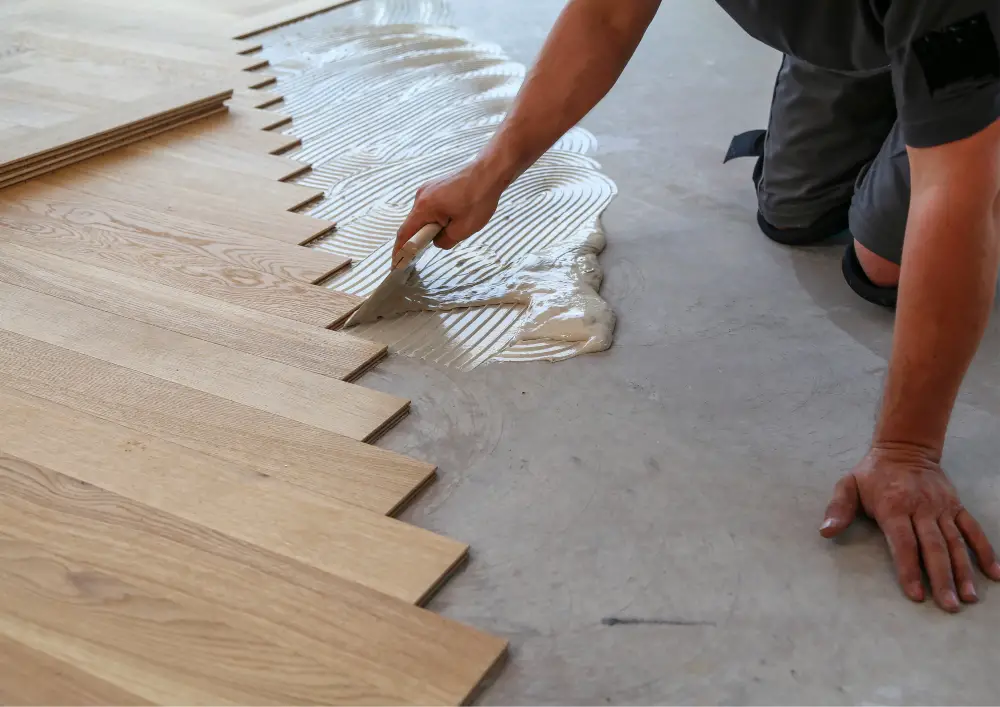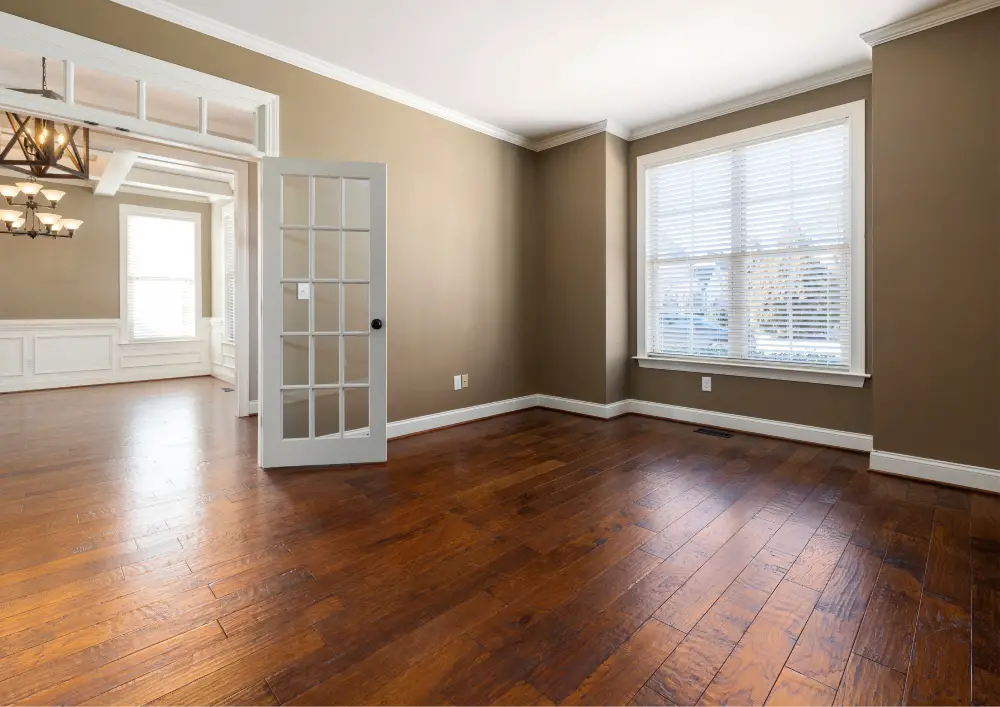Your home’s flooring is a significant investment since it lends to the look and functionality of the room. To get the right flooring, you need to carefully consider the flooring material.
Getting flooring material that matches your home’s style is easy by following this guide.
Contents
Types of Flooring Materials
Knowing what kind of flooring materials are available is the first step to knowing what kind of flooring fits your home.
Hardwood
Hardwood flooring material is made from timber. They come in various types, like oak, cherry, and maple. These floors give a timeless, elegant look and can last for decades with proper care.
Usually, hardwood is installed in living rooms, dining areas, and bedrooms. It’s not ideal for moist places like bathrooms or basements.
Pros: Durable, increases home value, easy to clean
Cons: Expensive, can scratch, sensitive to moisture
Stone
Stone flooring material includes options like marble, granite, and slate. These floors are naturally durable, and each piece is unique. They give a luxurious feel to your home.
Stone is often seen in entryways, kitchens, and bathrooms. It can be used outdoors for patios and walkways.
Pros: Long-lasting, elegant, unique patterns
Cons: Cold to the touch, costly, needs sealing to prevent stains
Laminate

Laminate flooring is made from pressed wood. It’s a cost-effective option that mimics the look of hardwood or stone. Laminate is easy to install and clean.
This flooring material is popular for areas like living rooms and bedrooms. It’s not the best choice for wet spaces like bathrooms.
Pros: Affordable, easy to install, versatile design options
Cons: Not as durable as hardwood, can’t be refinished, not good in moisture
Cork
Cork floors come from the bark of cork oak trees. They offer a soft, cushiony feel underfoot. Cork is also eco-friendly and can be an excellent sound insulator.
You’ll often find cork in home offices, kids’ rooms, and even kitchens. However, there are better fits for areas that get wet often, like bathrooms.
Pros: Eco-friendly, soft, good insulation
Cons: Sensitive to moisture, can be easily scratched, fades in sunlight
Concrete
Concrete is for more than just sidewalks and driveways. These days, people love it inside their homes, too. You can paint, stamp, or polish it until it shines.
Concrete is a big hit for places that need to be tough. Think garages, basements, and even trendy loft spaces.
Pros: Tough as nails, easy to care for, can look like anything you want
Cons: Unforgiving on your feet, can feel cold, might crack as it settles
Carpet
Carpet is the go-to for comfort. Who doesn’t love that soft landing underfoot? It’s made from things like nylon, polyester, or even wool.
Carpet is a favorite for bedrooms and cozy TV rooms. But avoid putting it in your kitchen or bathroom, where spills and messes are common.
Pros: Soft, keeps your toes warm, quiets down noise
Cons: Shows stains, wears out, holds onto smells
Linoleum
Linoleum is not plastic— it’s made from natural stuff like linseed oil. People love it because it lasts a long time and is kind to the Earth.
You’ll see linoleum in places like schools or hospitals. At home, it’s a good fit for kitchens and bathrooms.
Pros: Earth-friendly, stands up to a lot of foot traffic, easy to clean
Cons: Can get dents, may curl at the edges, colors might fade
Tile
Tile is the classic pick for spaces that get wet. Made from ceramic or stone, it’s as tough as it is good-looking.
Tiles are popular in bathrooms and kitchens. You’ll even see them outdoors, making patios look great.
Pros: Handles water like a champ, easy to clean, style choices galore
Cons: Feels cold, hard surface, grout can get grimy
Vinyl

Vinyl is like the chameleon of flooring. It can look like wood, tile, or even stone, but it’s easier on your wallet. It’s made from plastic, so it’s pretty tough stuff.
You’ll often find vinyl in kitchens, bathrooms, and laundry rooms. These are places where you need a floor that can handle spills.
Pros: Budget-friendly, holds up to water, comfy to walk on
Cons: Not very eco-friendly, can get scratched, might fade in strong sunlight
Engineered Wood
Engineered wood is almost like hardwood’s cousin. It’s got a layer of real wood on top, but underneath are layers of different materials. This makes it stable and less pricey.
This flooring works well in any room where you’d put hardwood. But it’s also better for places like basements where moisture can be an issue.
Pros: Looks like real wood, more stable in changing conditions, a bit cheaper than hardwood
Cons: Can’t be sanded down many times, not as long-lasting as hardwood, some people prefer the real thing
Rubber
Rubber floors are not just for gyms. They’re bouncy and soft, made from natural tree rubber or recycled materials.
Rubber is good for rooms where you’ll be on your feet, like kitchens or home gyms. It’s also a popular pick for kids’ playrooms.
Pros: Soft on your feet, durable, can be eco-friendly
Cons: Can smell rubbery at first, not the best look for every room, can stain easily
Marble
Marble is the epitome of luxury when it comes to flooring. This natural stone comes from mountains and has a timeless, elegant look.
Marble is often installed in high-end homes, particularly in bathrooms, entryways, and living rooms. It’s not the best for kitchens because it can stain easily.
Pros: Very luxurious, unique patterns, add value to your home
Cons: Expensive, can stain and scratch easily, needs regular sealing
Important Factors in Choosing a Flooring Material

Usage
When picking flooring, think about what that room will go through. The living room floor sees a lot of action: people walking, kids playing, and maybe even pets running around. So, you’ll want something that can take the wear and tear. On the other hand, a bedroom might see less foot traffic.
You could go for something softer and more comfortable there. Are you looking to floor a kitchen? Consider something easy to clean and can handle spills. And for a bathroom, you’ll need flooring that won’t get ruined by water or humidity. So, before you pick, think about life in that room.
Budget
Money talks, especially when it comes to home projects. Some flooring materials will make your wallet happier than others. For example, hardwood and stone look stunning but have a hefty price tag. If you love their look rather than their cost, consider alternatives.
Engineered wood or laminate can mimic hardwood. Vinyl can look like stone but costs a lot less. And remember extra costs like installation, which can add up.
Also, think long-term. A cheaper flooring material might last less, costing you more in the long run. So, weigh both the upfront and future costs when making your decision.
Interior and Exterior Decoration
The floor is a big part of any room’s style. So you’ll want something that fits with your decor. If you’re into a modern look, polished concrete or sleek tile might be up your alley. For a cozy vibe, carpet or hardwood could be a better fit. But think about more than just the room itself.
Consider how the flooring will look with the rest of your house. Consistency can make your home feel pulled together. Plus, if you’re flooring an outdoor space like a patio, think about how it’ll look from the inside. That way, your home’s look flows nicely from inside to out.
Installation Process
When you have your flooring material in mind, below are the steps for installing your flooring:
Measure Your Space
Measuring isn’t just pulling out a tape measure and jotting down numbers. You’ve got to think about doorways, corners, and other odd spots that’ll need flooring. A pro tip? Always add about 10% extra to your final measurement. This accounts for errors or last-minute changes. No one wants to pause installation to return to the store for one more tile box.
Prepare Your Supplies & Tools
Sure, you’ll need the flooring material, but what about the other stuff? If you’re laying down hardwood, you’ll need nails and a special nail gun. Ensure your power tool is a reputable brand, for a consistent and interruption-free installation.
Prep the Area
This is more than just sweeping up. Depending on the chosen flooring material, you may need to remove old flooring. Do squeaky boards or uneven spots? Fix those before laying down anything new. And if you’re working in a space like a bathroom, ensure everything is dry. Water and new flooring need to be fixed.
Lay the Underlayment
The underlayment is like the unsung hero of flooring. It can help make your floor last longer and feel better underfoot. Some flooring materials, like laminate, need a special underlayment to stop moisture. Even if you think you can skip this step, don’t. The underlayment can make or break how happy you are with your new floor.
Install the Flooring
You’re probably eager to see how your new floor will look. But slow down and take your time. Each type of flooring has its quirks when it comes to installation. If you’re putting down tiles, you must carefully space each and apply grout. Hardwood usually needs to be nailed in a specific pattern. Make sure to follow the rules for your chosen material.
Finish and Seal
You’re almost there. The floor is down, but you’re not done yet. Depending on the flooring material, you may need to seal it. This helps protect it from wear and tear. A nice stain can bring out the wood’s natural beauty if you’ve gone with hardwood. And don’t overlook things like molding or trimming around the edges. It’s like the frame for your new floor and can make it look truly finished.
Flooring Maintenance

Hardwood
Cleaning Materials Needed:
- Soft-bristle broom
- Microfiber mop
- pH-balanced wood cleaner
- Soft, absorbent cloth
Hardwood floors are classic but need a gentle touch. Start by sweeping with a soft-bristle broom to get rid of dirt and dust. Avoid using water as much as possible; it can damage the wood. Use a microfiber mop and pH-balanced wood cleaner for a deeper clean. Just dampen the mop; don’t soak it.
Wipe spills quickly with a soft cloth to avoid stains or water damage. Consider a professional polish every few years to keep your hardwood looking great.
Carpet
Cleaning Materials Needed:
- Vacuum cleaner with good suction
- Spot cleaner for stains
- Baking soda
- Steam cleaner (for deep cleans)
Carpet flooring feels great underfoot but can trap a lot of dirt. A regular vacuum is your best friend here. Aim to vacuum at least once weekly to keep the dirt and dust at bay. Got a stain? Use a spot cleaner right away.
For a deeper clean, consider using a steam cleaner; you can rent one if you don’t want to buy one. If your carpet smells, sprinkle some baking soda, let it sit, and vacuum it up. Remember, a good deep clean at least once a year will help your carpet last longer.
Tile
Cleaning Materials Needed:
- Soft-bristle broom or vacuum
- Mop
- Mild detergent or tile cleaner
- Soft cloth or sponge
- Grout cleaner
Tile is pretty forgiving, but it needs some love, too. Sweep or vacuum to remove loose dirt and debris. Then, use a mop with a mild detergent or a tile cleaner. Avoid harsh chemicals; they can dull your tile.
Wipe the surface dry with a cloth to prevent water spots. Remember the grout. It can get dirty and change color. Use a grout cleaner and scrub with a soft brush to keep it looking fresh.
Vinyl
Cleaning Materials Needed:
- Microfiber mop or cloth
- pH-neutral cleaner
- Soft-bristle broom
- Water
Vinyl is one of the easier floors to maintain. Start with a soft-bristle broom to sweep away dirt. For a deeper clean, use a microfiber mop dampened with warm water. If you need a cleaner, ensure it’s pH-neutral to keep the vinyl from getting damaged.
Avoid using abrasive pads or brushes; they can scratch the surface. Also, avoid waxy or oily cleaners; they can leave a film. A simple, gentle clean once a week should keep your vinyl floors looking good.
Marble
Cleaning Materials Needed:
- Soft cloth or sponge
- pH-neutral cleaner made for stone
- Soft-bristle broom
- Warm water
- Sealant for marble
Marble is gorgeous but also demanding. It needs tender, loving care to stay that way. A soft-bristle broom works well for daily sweeping. Avoid acidic or abrasive cleaners; they’ll dull or scratch the marble. Instead, use a pH-neutral cleaner designed for stone.
A damp, soft cloth or sponge is perfect for wiping the surface. Once or twice a year, you should also seal your marble floors. This practice will protect them from stains and keep them looking their best for years.
Conclusion
Choosing a flooring is more than just picking a flooring material you like. You’ve got to think about where it’s going, how much it’ll cost, and even how hard it is to maintain. But the effort pays off when you step back and see how the right floor can transform a room. And once it’s in, knowing how to take care of it can make your choice last for years.
So whether you’re building a new house or just refreshing an old room, take the time to pick the perfect floor.





